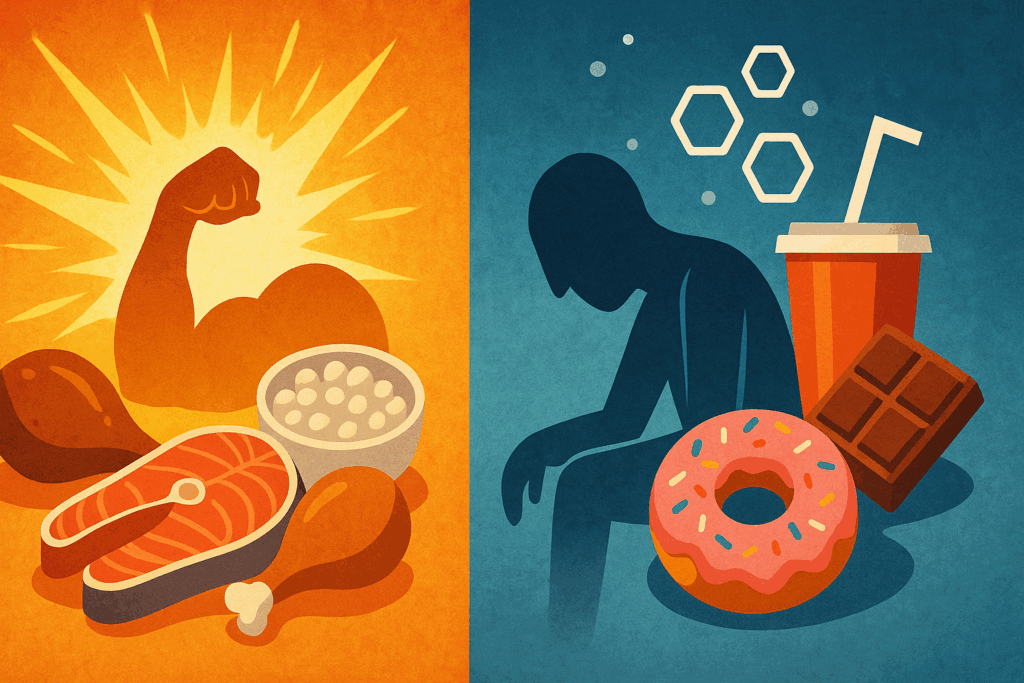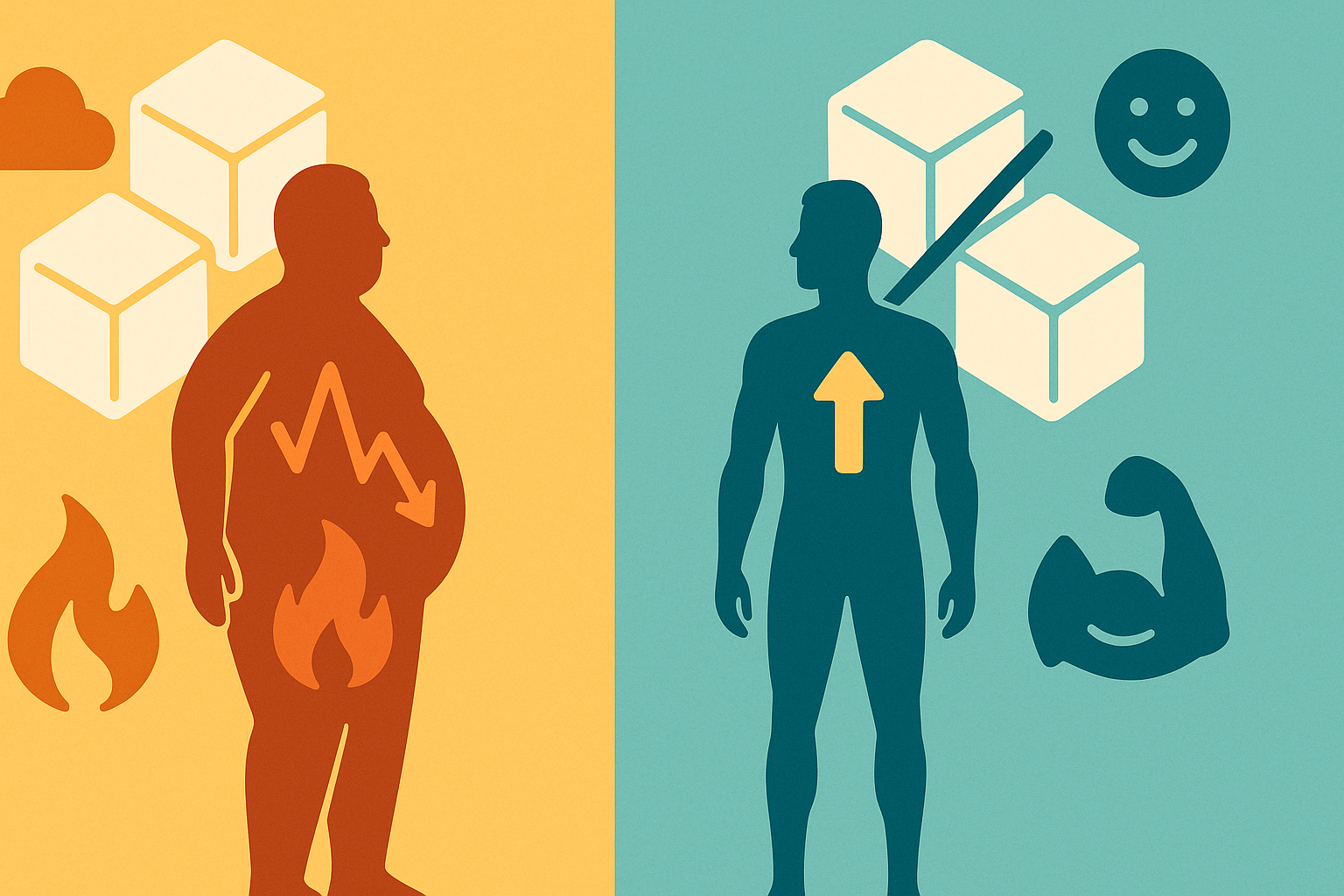In the ever-evolving landscape of nutritional science, few dietary approaches have received as much acclaim for promoting lasting energy and robust health as the high protein low sugar diet. This eating pattern is not merely a fleeting trend but rather a scientifically grounded strategy that supports metabolism, preserves lean muscle mass, and combats the destabilizing effects of sugar-laden meals. For those seeking a sustainable way to fuel their day while maintaining a healthy weight, controlling cravings, and optimizing their cognitive performance, adopting a high protein low sugar lifestyle offers a compelling path forward.
You may also like : The Ultimate Guide to Choosing a High Protein Diet Name That Fits Your Goals

Understanding the Science Behind Protein and Sugar Metabolism
At the heart of any dietary strategy lies the body’s metabolic response to macronutrients. Protein is unique in its thermogenic effect, meaning it requires more energy to digest, absorb, and metabolize compared to fats and carbohydrates. This process not only boosts caloric expenditure but also enhances satiety, reducing the urge to snack between meals. Additionally, protein provides the amino acids essential for muscle repair, hormone synthesis, immune function, and enzyme production.
Conversely, dietary sugars, particularly refined and added sugars, are rapidly absorbed into the bloodstream, causing a spike in insulin levels. This rollercoaster of blood glucose can lead to energy crashes, mood swings, and long-term metabolic dysfunction such as insulin resistance. When sugar intake consistently exceeds the body’s immediate energy needs, it is stored as fat, contributing to weight gain and an increased risk of chronic diseases.
By prioritizing protein while minimizing sugar, individuals create a metabolic environment conducive to fat loss, muscle preservation, and sustained energy. This makes the high protein low sugar model especially attractive to those with active lifestyles, metabolic conditions, or cognitive demands.

Why High Protein Low Sugar Diets Enhance Energy and Focus
One of the most immediate benefits reported by individuals transitioning to a high protein low sugar approach is a marked improvement in mental clarity and energy stability. Protein-rich foods provide a steady release of glucose over time, preventing the sharp dips in blood sugar that are often associated with irritability, fatigue, and difficulty concentrating.
Neurochemically, protein also plays a direct role in neurotransmitter production. Amino acids such as tryptophan, tyrosine, and glutamine serve as building blocks for serotonin, dopamine, and GABA, which are critical for mood regulation, alertness, and focus. When sugar intake is reduced, the brain avoids the addictive highs and lows associated with hyperglycemia, allowing for more balanced emotional and cognitive functioning.
Incorporating sources like eggs, fish, poultry, legumes, and low-glycemic vegetables into meals creates a synergistic effect that sustains energy levels throughout the day. This is especially important for professionals, students, and athletes who rely on optimal mental and physical performance.
Debunking Myths About the High Protein High Fat Diet
While often conflated with high-fat diets, the high protein low sugar model can exist independently or synergistically with higher fat intake. The high protein high fat diet, when comprised of whole, nutrient-dense foods, offers numerous metabolic benefits. Contrary to outdated beliefs, dietary fat does not inherently lead to fat gain. Instead, it serves as a slow-burning energy source, supports cellular integrity, aids in vitamin absorption, and contributes to hormone production.
The fear that high protein intake may harm kidney function has also been largely debunked in healthy individuals. Studies show that protein-rich diets do not impair renal function in people without pre-existing kidney disease. In fact, such diets may offer protective benefits through better weight management and improved metabolic health.
Combining moderate-to-high protein with healthy fats such as avocado, olive oil, nuts, and fatty fish enhances satiety and reduces the tendency to graze on sugary snacks. This combination makes it easier to adhere to long-term dietary changes and reduces the likelihood of nutritional deficiencies.

Designing Balanced Meals with a High Protein Low Sugar Focus
Creating a balanced, satisfying meal within the high protein low sugar framework begins with understanding macronutrient distribution and food quality. Start with a protein anchor such as grilled chicken, baked salmon, tofu, or grass-fed beef. Complement this with fibrous vegetables like spinach, broccoli, or cauliflower, which provide bulk, antioxidants, and essential micronutrients without a sugar overload.
Healthy fats can be incorporated through toppings like sunflower seeds, chia seeds, or a drizzle of flaxseed oil. Legumes and whole grains such as quinoa or lentils may be added in moderation to support fiber and mineral intake, though the focus should remain on minimizing processed carbohydrates and hidden sugars.
The goal is to construct meals that are nutrient-dense, visually appealing, and flavorful. Herbs, spices, vinegars, and fermented foods can amplify taste without contributing sugar, enhancing both palatability and digestive health. Strategic meal planning also helps minimize decision fatigue and ensures consistency.

Understanding the Risks of a High Sugar Diet
Reducing sugar is not simply about lowering caloric intake; it’s about protecting the body from the deleterious effects of metabolic dysregulation. Excessive sugar consumption has been linked to a litany of health issues, including obesity, type 2 diabetes, cardiovascular disease, fatty liver disease, and certain cancers. Additionally, recent research highlights the role of sugar in exacerbating inflammation and accelerating aging processes at the cellular level.
For example, advanced glycation end products (AGEs) form when sugar molecules bind to proteins or lipids, impairing their function and contributing to oxidative stress. This process damages tissues and can hasten the development of age-related diseases such as Alzheimer’s and atherosclerosis.
Moreover, sugar’s addictive properties create a feedback loop in the brain’s reward system, making it difficult to reduce intake without structured dietary support. A high protein low sugar diet offers a natural antidote by curbing cravings and normalizing hunger hormones like leptin and ghrelin.

Transitioning to a High Protein No Sugar Diet: Is It Realistic?
While eliminating sugar completely may seem daunting, many individuals find that a high protein no sugar diet becomes more manageable with time and the right strategies. It begins with label literacy—recognizing hidden sources of sugar in packaged foods, sauces, condiments, and even seemingly healthy items like yogurt or granola bars.
Whole food preparation becomes a cornerstone of this lifestyle. Cooking at home allows for control over ingredients and avoids the pitfalls of restaurant meals laden with sugar-rich marinades, dressings, and side dishes. Meal prep strategies such as batch cooking, freezer meals, and protein-rich snacks (like hard-boiled eggs, turkey roll-ups, or hummus with veggies) help maintain adherence during busy periods.
Crucially, palate retraining plays a psychological role. Over time, as the body recalibrates to a lower sugar threshold, natural flavors become more pronounced, and the desire for hyper-sweet foods diminishes. This is often a turning point where individuals no longer feel deprived but instead empowered by their new sense of taste and control.
The Role of the High Protein Low Sugar Diet in Weight Management
One of the most compelling reasons to embrace a high protein low sugar diet is its effectiveness in promoting healthy weight loss and long-term weight maintenance. Unlike restrictive, calorie-counting methods that often result in rebound weight gain, this approach works by addressing the root causes of overeating—hormonal imbalances, blood sugar instability, and chronic cravings.
Protein stimulates the release of peptide YY and glucagon-like peptide-1 (GLP-1), both of which signal satiety and reduce food intake. Simultaneously, reduced sugar intake lowers insulin spikes, allowing the body to burn stored fat more efficiently. This dual-action mechanism supports a steady reduction in body fat without the emotional rollercoaster of crash dieting.
Furthermore, preserving lean muscle through adequate protein intake is crucial during weight loss, as muscle is metabolically active tissue that influences basal metabolic rate (BMR). Higher BMR translates to greater calorie expenditure, making it easier to maintain a healthy weight over time without excessive restriction.
How to Make the High Protein Low Sugar Diet Work for Athletes and Active Individuals
Athletes, fitness enthusiasts, and highly active individuals have unique nutritional needs, and the high protein low sugar diet can be tailored to support their performance and recovery. Protein is vital for muscle repair, growth, and enzymatic functions that underpin energy metabolism. After intense workouts, consuming fast-digesting proteins like whey isolate alongside low-sugar fruits such as berries can optimize glycogen replenishment without the insulin spike of traditional sports drinks.
Carbohydrate timing becomes particularly important in this context. By aligning moderate carb intake around workouts and prioritizing protein and fats during other meals, athletes can achieve energy balance while preserving the benefits of a low sugar baseline. Complex carbohydrates like sweet potatoes or brown rice can be strategically introduced when additional glycogen is needed.
Hydration and electrolyte balance are also critical. High protein intake increases nitrogen excretion, which can influence hydration needs. Active individuals should ensure they are consuming adequate water and mineral-rich foods to support kidney function and muscle performance.
Innovative Ways to Incorporate High Protein Low Sugar Principles
Creativity in the kitchen plays a vital role in the long-term success of a high protein low sugar diet. While traditional sources of protein such as meats, eggs, and legumes remain staples, modern food science and culinary trends have introduced a wealth of exciting options. For instance, collagen peptides can be added to smoothies, soups, or coffee to boost protein without altering flavor. Plant-based eaters may turn to textured vegetable protein (TVP), hemp seeds, and fermented soy products like tempeh to meet their needs.
Low-sugar desserts and baked goods can be crafted using almond flour, coconut flour, erythritol, or stevia to provide sweetness without the metabolic impact. High-protein pancakes, chia pudding, and Greek yogurt parfaits with fresh berries offer satisfying alternatives to sugar-laden breakfasts. The use of umami-rich ingredients—such as mushrooms, tamari, and roasted nuts—also enhances the savory appeal of meals and reduces the craving for sweetness.
Batch-cooking and freezer-friendly meals allow individuals to maintain dietary integrity even during busy weeks. Recipes like turkey meatballs with cauliflower mash, salmon patties with arugula, or lentil stew with spinach are not only practical but also deeply nourishing. These innovations help individuals remain enthusiastic and engaged with their food choices, preventing the boredom that often undermines restrictive diets.

Breaking the Cycle of Food Addiction with Protein
Modern food environments, dominated by hyper-palatable, processed foods, often trigger addiction-like responses in the brain. Foods high in sugar and low in protein rapidly stimulate dopamine release, creating a powerful reward loop that can override natural satiety signals. This is not just a matter of willpower; it’s a neurochemical hijacking of the brain’s reward system.
A high protein low sugar diet offers a way to interrupt this cycle. Protein takes longer to digest, has a minimal impact on blood glucose, and provides the amino acids necessary for balanced neurotransmitter production. Tyrosine, for example, is a precursor to dopamine and norepinephrine, supporting natural motivation and focus without the crash that follows sugary foods.
Furthermore, adopting this dietary approach helps normalize endorphin and serotonin activity over time. With fewer dopamine spikes from sugar and more consistent nutritional support from protein, the brain gradually recalibrates its reward expectations. This process makes it easier to resist processed foods and embrace whole, nutrient-dense options as genuinely satisfying.
Meal Prep Tips for Staying Consistent on a High Protein Low Sugar Diet
Consistency is the linchpin of any successful dietary strategy, and meal prep can be a game-changer for those committed to a high protein low sugar lifestyle. Begin by setting aside time each week to plan meals, create grocery lists, and prepare ingredients. This not only saves time but also reduces the temptation to default to convenience foods that are high in sugar and low in nutritional value.
Invest in quality storage containers and portion out meals in advance. Options like overnight oats with unsweetened protein powder, grilled chicken salads with olive oil dressing, or lentil-based soups offer diversity while adhering to dietary principles. Snacks such as cottage cheese, boiled edamame, or almond butter with celery can be prepared in advance and accessed easily.
Rotating protein sources each week prevents dietary fatigue. Consider introducing international cuisines that emphasize lean proteins and spices, such as Mediterranean, Indian, or Korean dishes, which can be adapted to minimize sugar and maximize flavor. Over time, meal prep evolves from a chore to a creative expression of health-conscious living.
Sustainability and Ethical Sourcing in a High Protein Lifestyle
An often under-discussed aspect of a high protein low sugar diet is its ecological and ethical footprint. As demand for high-quality protein rises, so does the importance of sourcing it sustainably. Choosing grass-fed, pasture-raised, and organic animal products supports both environmental stewardship and animal welfare. These sources often offer superior nutrient profiles, with higher levels of omega-3 fatty acids, vitamin E, and conjugated linoleic acid (CLA).
Plant-based proteins such as lentils, beans, and tofu tend to have lower environmental impacts, especially when sourced from regenerative agriculture systems. For those concerned about food miles and emissions, locally sourced products and seasonal vegetables offer an eco-friendly way to enhance diet quality without compromising values.
Additionally, integrating more fish and seafood—especially varieties certified by the Marine Stewardship Council (MSC)—can provide high-quality protein along with essential micronutrients like iodine, selenium, and vitamin D. These considerations enrich the ethical dimensions of dietary choices, allowing individuals to align their nutritional goals with broader social and environmental values.
Psychological and Emotional Benefits of Nutritional Stability
The emotional volatility linked to high sugar consumption is well documented. Sugar highs and lows often mirror mood swings, contributing to irritability, anxiety, and depressive symptoms. Conversely, stable blood sugar levels achieved through a high protein low sugar diet can promote emotional equilibrium and cognitive resilience.
Protein supplies the amino acids needed for neurotransmitters like serotonin (for mood), dopamine (for motivation), and GABA (for relaxation). When these brain chemicals are produced in balanced amounts, individuals often report improved mood regulation, reduced anxiety, and more consistent motivation. This reinforces the psychological benefits of dietary adherence.
Moreover, mastering dietary control can boost self-efficacy and confidence. As individuals begin to feel better, perform better, and gain greater command over their food environment, they often experience a positive feedback loop of emotional well-being. These psychological gains are as vital as physical improvements and contribute to long-term success.

Customizing the High Protein Low Sugar Diet for Different Life Stages
Nutritional needs vary across the lifespan, and the high protein low sugar approach can be adapted to support each stage of life. In adolescence, a critical window for growth and development, protein supports muscle and bone formation while reducing the risk of insulin resistance often driven by sugary snacks. Encouraging teenagers to consume protein-rich breakfasts and limit sugary sodas can establish lifelong healthy eating habits.
During pregnancy and breastfeeding, protein is essential for fetal development and maternal recovery. Choosing low-sugar, high-protein options like eggs, fish, nuts, and legumes helps support stable blood sugar and optimal nutrient delivery to the baby. Nutritional planning in this stage can reduce the risk of gestational diabetes and promote healthier birth outcomes.
In older adults, preserving muscle mass becomes a top priority. Sarcopenia, or age-related muscle loss, is a significant predictor of frailty and loss of independence. A diet high in quality protein and low in sugar supports muscle protein synthesis and prevents the inflammation that accelerates aging. Combined with resistance training, this dietary pattern can dramatically enhance quality of life in later years.
Potential Challenges and How to Overcome Them
Despite its many benefits, transitioning to a high protein low sugar diet is not without its hurdles. One common challenge is the social aspect of food. Dining out, attending events, or sharing meals with others may introduce sugar-laden options that challenge your resolve. Clear communication and planning ahead—such as checking menus or bringing a dish to share—can alleviate these situations.
Budget is another consideration. While some perceive protein-rich foods as expensive, strategic shopping—such as buying in bulk, choosing seasonal produce, and utilizing cost-effective protein sources like eggs, canned tuna, and beans—can keep expenses manageable. The long-term savings on healthcare costs also make this an investment in your future wellbeing.
Finally, overcoming initial sugar withdrawal symptoms requires both physiological support and psychological resilience. Symptoms such as headaches, irritability, or fatigue typically subside within a few days. Staying hydrated, sleeping well, and supplementing with electrolytes can ease this process. Support groups, tracking progress, and setting realistic goals reinforce commitment and provide motivation during the adjustment period.
Exploring Global Cultural Traditions that Align with High Protein Low Sugar Principles
Across the globe, many traditional diets naturally align with high protein low sugar values. The Mediterranean diet, for instance, emphasizes lean proteins like fish and legumes, healthy fats from olives and nuts, and minimal sugar intake from sweets. Japanese cuisine relies heavily on fish, tofu, seaweed, and fermented vegetables, all of which support gut health and protein adequacy.
Indigenous diets in regions like Africa, South America, and the Arctic often reflect seasonal eating, whole animal consumption, and minimal processed sugars. These foodways, developed over centuries, demonstrate how traditional wisdom can inform modern nutritional choices. Reconnecting with ancestral eating patterns not only supports health but also strengthens cultural identity and respect for heritage.
Integrating these global influences allows for a more diverse and enjoyable eating experience. It reduces the risk of palate fatigue and brings a sense of cultural richness and creativity to everyday meals. These culinary explorations also expand the nutrient spectrum, ensuring a well-rounded approach to high protein low sugar living.
Frequently Asked Questions About the High Protein Low Sugar Lifestyle
1. How does a high protein low sugar diet influence long-term brain health?
Over time, a high protein low sugar diet can profoundly affect brain health by reducing glycemic variability, a known factor in cognitive decline. Chronic high sugar intake contributes to insulin resistance in the brain, which has been linked to memory loss and increased risk of neurodegenerative conditions like Alzheimer’s disease. Protein, on the other hand, provides the amino acids needed to produce neurotransmitters such as dopamine and serotonin, which regulate mood and cognition. By stabilizing blood sugar levels, the brain is less susceptible to inflammatory damage and oxidative stress. Long-term adherence to this diet supports not only sharper thinking but also emotional resilience and improved mental stamina.
2. Can a high protein no sugar diet be effective for managing autoimmune conditions?
Yes, a high protein no sugar diet can offer notable benefits for individuals with autoimmune disorders. Emerging research suggests that sugar consumption exacerbates systemic inflammation, which plays a significant role in autoimmune flare-ups. Reducing sugar can help modulate the immune response, while high-quality protein supports tissue repair and antibody production. Furthermore, low sugar intake contributes to a healthier gut microbiome, which is critical for immune regulation. Although it is not a cure, this dietary approach can serve as a supportive tool to reduce symptom severity and enhance overall quality of life in autoimmune patients.
3. What are the emotional and psychological benefits of a high protein high fat diet with minimal sugar?
Following a high protein high fat diet with minimal sugar can positively reshape one’s emotional and psychological landscape. High protein meals contribute to stable neurotransmitter production, enhancing mood stability and focus. Healthy fats, such as omega-3 fatty acids, are vital for brain membrane function and have been associated with reduced symptoms of depression and anxiety. By eliminating the blood sugar rollercoaster induced by high-sugar foods, individuals often report a calmer, more balanced emotional state. Additionally, the sense of control that comes with disciplined eating patterns often translates to improved self-esteem and a more empowered mindset.
4. How can I sustain a high protein low sugar diet while traveling or attending social events?
Maintaining a high protein low sugar diet during travel or social gatherings requires preparation and strategic decision-making. Start by identifying protein-rich portable snacks like jerky, roasted chickpeas, or hard-boiled eggs that can be packed ahead of time. At restaurants, prioritize grilled meats, leafy salads, and vegetable sides while requesting sauces and dressings on the side to control hidden sugar intake. At social events, focus on protein-based appetizers or bring a compliant dish to share. Staying hydrated and avoiding alcohol or sweetened beverages also helps maintain metabolic stability. With a proactive approach, it becomes easier to make choices aligned with your dietary values even outside of your routine environment.
5. What impact does the high protein low sugar approach have on skin health and appearance?
This dietary pattern can significantly improve skin clarity, texture, and elasticity over time. Sugar consumption promotes the formation of advanced glycation end products (AGEs), which damage collagen and accelerate skin aging. Reducing sugar allows the skin’s natural repair processes to work more efficiently, leading to fewer breakouts and more even tone. Meanwhile, protein provides the building blocks for collagen and elastin, essential for skin firmness and hydration. Nutrient-dense, high protein foods like eggs, fatty fish, and legumes also deliver zinc and biotin, key nutrients in skin regeneration. The cumulative effect is a more radiant, youthful complexion without relying on expensive topical treatments.
6. Is a high protein no sugar diet sustainable for vegetarians or vegans?
Absolutely, with mindful planning, a high protein no sugar diet can be adapted to suit plant-based lifestyles. Protein sources such as lentils, chickpeas, tofu, tempeh, seitan, and edamame can be combined with seeds and nuts to meet amino acid needs. Fermented foods and high-fiber vegetables enhance gut health and nutrient absorption. It’s essential to read labels carefully, as many plant-based packaged foods contain added sugars. Supplementation with vitamin B12, iron, and omega-3s may also be necessary for nutritional adequacy. With creativity and attention to food sourcing, plant-based eaters can thrive on this diet while maintaining metabolic and emotional balance.
7. Can a high protein low sugar plan help with hormonal balance during menopause?
Yes, the high protein low sugar approach can be particularly beneficial for women experiencing hormonal shifts during menopause. High sugar intake can worsen insulin resistance, exacerbate weight gain, and intensify symptoms such as hot flashes and mood swings. Protein helps stabilize blood glucose levels and supports lean muscle maintenance, which is crucial as estrogen levels decline. Healthy fats included in many high protein high fat diet plans can further support hormone production and reduce inflammation. Additionally, prioritizing low-glycemic vegetables and whole foods helps offset hormonal fluctuations and promotes better sleep, energy, and libido.
8. How does the high protein low sugar lifestyle support muscle recovery and athletic performance?
Athletes and active individuals can reap significant benefits from this dietary model, especially regarding recovery and performance longevity. Protein is essential for muscle repair and synthesis, and its intake around workouts ensures more efficient healing and adaptation. Reducing sugar reduces post-exercise inflammation and prevents energy crashes that hinder recovery. For those on a high protein high fat diet, fats serve as a slow-burning fuel, enhancing endurance in aerobic activities. Strategic carbohydrate reintroduction from low-glycemic sources post-workout can be incorporated without compromising the low sugar framework. Overall, the high protein no sugar diet supports consistent performance, reduces injury risk, and fosters lean muscle retention.
9. What are the best supplements to support a high protein low sugar diet?
While whole foods should remain the dietary foundation, targeted supplements can enhance results and simplify adherence to a high protein low sugar routine. Whey or plant-based protein powders without added sugars are excellent for boosting protein intake on busy days. Omega-3 fatty acids, magnesium, and vitamin D can help combat inflammation and support metabolic health. Digestive enzymes and probiotics may aid in nutrient absorption and gut function, especially during dietary transitions. Chromium and alpha-lipoic acid can support blood sugar regulation for those reducing carbohydrate intake. As with any supplementation plan, it is best to consult with a healthcare provider for personalized recommendations.
10. What future trends might shape the evolution of high protein low sugar diets?
Emerging trends are likely to refine and personalize the high protein low sugar lifestyle even further. Advances in nutrigenomics are enabling tailored dietary plans based on genetic and microbiome data, allowing for more precise protein and sugar recommendations. Alternative protein sources such as lab-grown meat, insect protein, and algae are being developed to offer sustainable, ethical options. Wearable technology and continuous glucose monitoring may soon allow real-time feedback on dietary choices. Additionally, culinary innovations are producing high-protein, zero-sugar functional foods that cater to convenience without compromising quality. As science and technology evolve, the high protein no sugar diet will continue to become more accessible, efficient, and adaptable to individual health goals.
Conclusion: Building Lasting Health Through a High Protein Low Sugar Lifestyle
A high protein low sugar diet is more than a nutritional plan—it’s a comprehensive approach to improving energy, focus, metabolic health, and emotional resilience. By reducing sugar’s grip on appetite and metabolism and emphasizing the power of protein, this dietary shift empowers individuals to take control of their health without relying on gimmicks or deprivation. Whether your goal is to lose weight, enhance mental performance, or simply feel more vibrant day-to-day, the high protein low sugar lifestyle offers a sustainable path toward transformation.
Through informed food choices, consistent preparation, and a mindset rooted in long-term wellbeing, this way of eating becomes not only achievable but enjoyable. The body thrives when fueled by steady, nourishing inputs, and the brain rewards these efforts with clarity, mood balance, and motivation. As dietary science continues to evolve, the foundational truths behind high protein low sugar eating remain clear: lasting health is built on stability, not spikes—and protein provides the scaffolding on which that stability rests.
Further Reading:
30-Day No-Sugar, High-Fiber & High-Protein Meal Plan, Created by a Dietitian
25 High-Protein, Low-Sugar Snacks To Keep You Energized and Full





